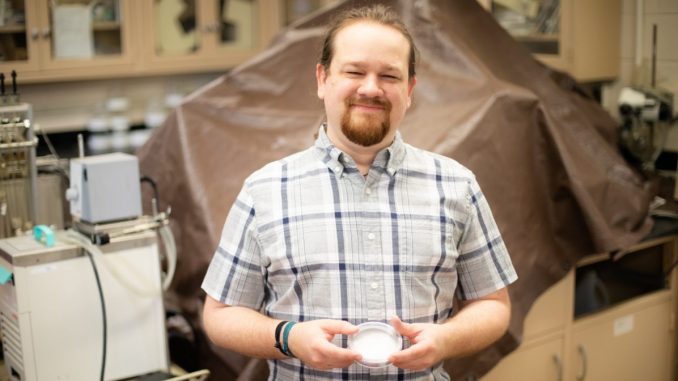By Zachary Turner

Imagine an oblong creature that can fit on the tip of your pencil. A soda straw mouth pokes out from between two beady black eyes, while six little legs propel this creature to its next meal. This troublesome speck is called a tobacco thrip and it is responsible for millions of dollars in agricultural losses as it spreads disease among crops.
Mike Roe is a professor of entomology at North Carolina State University, and he spends a lot of time thinking about how you keep something the size of a drop of water away from a plant without also depriving it of, well, water.
Roe and his team recently published a paper on a new type of crop cover, which they call “plant armor.”
In one experiment, Roe and his team spread the plant armor over the PVC pipes to cover the crops. The fabric is composed of two outside layers with a third layer that spans between the other two. It is this third layer that creates a “torturous” path, making it very difficult for insects to infiltrate while still allowing life-giving water to reach the plants. Grayson Cave, a graduate researcher, stood next to the plot and spread the cloth out between his hands.

Cave said the experiment was similar to an obstacle course show. The third inner layer resembles the “perpendicular pillars hanging from the ceiling,” poised to knock contestants into the water below. In this scenario, the bug is our contestant. But out in the field, the game is life or death, and the contestant only has hours to win before it dies of starvation. Fortunately, outside the lab, pests have other options for food. When presented with the choice between navigating an obstacle course or foraging elsewhere, Cave hopes the bugs will choose the path of least resistance.

Inside an enclosed, circular dish, a layer of plant armor separates the bugs from their meal: a leaf of cabbage. The researchers placed 10 thrips on the fabric, which in turn took 175 minutes to traverse the mazelike cloth. “That is quite near that is near the actual lifespan of the insect without any food or water,” Cave said.
According to Roe, the team’s plant armor might help protect international crops as well. Marcel Deguenon is a postdoctoral research scholar who is exploring their product’s application in other parts of the world.
“In Africa, there are all the crop covers that people use,” said Deguenon. “But usually, those are bed nets that are treated with insecticides.”
On any farm, the application of pesticides can have unintended consequences. For example, runoff from farms during a storm can lead to increased levels of nitrogen in the local water supply. Elevated nutrient levels can in turn provoke harmful algal blooms and fish kills, causing problems for aquaculture and fishers. Deguenon says that their product is an insecticide free net and could benefit organic farmers.
“People want more more protection, but less chemicals,” Deguenon said.
The team is also exploring other uses for their textile that extend beyond agriculture. Because of its maze-like interior, the fabric can be designed with bigger holes and improved ventilation.
“I think one of the applications for this would be maybe clothing that could be made out of this to prevent insect from mosquito from biting people,” said Deguenon.

Be the first to comment